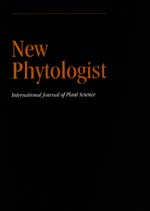Article contents
Mycorrhizal fungi have a potential role in soil carbon storage under elevated CO2 and nitrogen deposition
Published online by Cambridge University Press: 01 July 2000
Abstract
In this review, we discuss the potential for mycorrhizal fungi to act as a source or sink for carbon (C) under elevated CO2 and nitrogen deposition. Mycorrhizal tissue has been estimated to comprise a significant fraction of soil organic matter and below-ground biomass in a range of systems. The current body of literature indicates that in many systems exposed to elevated CO2, mycorrhizal fungi might sequester increased amounts of C in living, dead and residual hyphal biomass in the soil. Through this process, the fungi might serve as a negative feedback on the rise in atmospheric CO2 levels caused by fossil fuel burning and deforestation. By contrast, a few preliminary studies suggest that N deposition might increase turnover rates of fungal tissue and negate CO2 effects on hyphal biomass. If these latter responses are consistent among ecosystems, C storage in hyphae might decline in habitats surrounding agricultural and urban areas. When N additions occur without CO2 enrichment, effects on mycorrhizal growth are inconsistent. We note that analyses of hyphal decomposition under elevated CO2 and N additions are extremely sparse but are critical in our understanding of the impact of global change on the cycling of mycorrhizal C. Finally, shifts in the community composition of arbuscular and ectomycorrhizal fungi with increasing CO2 or N availability are frequently documented. Since mycorrhizal groups vary in growth rate and tissue quality, these changes in species assemblages could produce unforeseeable impacts on the productivity, survivorship, or decomposition of mycorrhizal biomass.
Keywords
Information
- Type
- Research review
- Information
- Copyright
- © Trustees of the New Phytologist 2000
- 341
- Cited by

